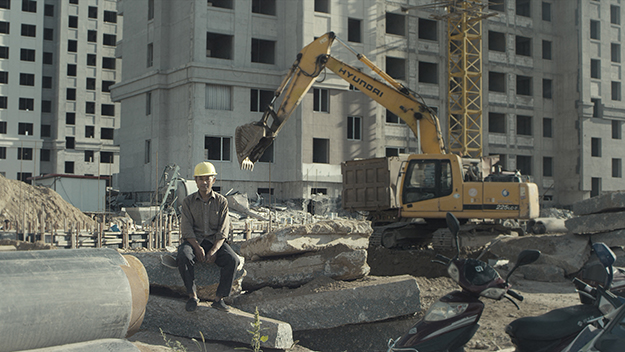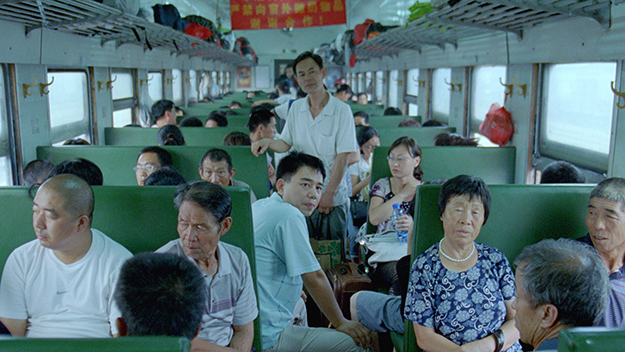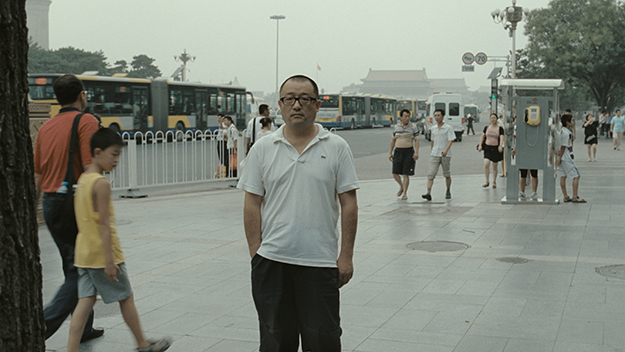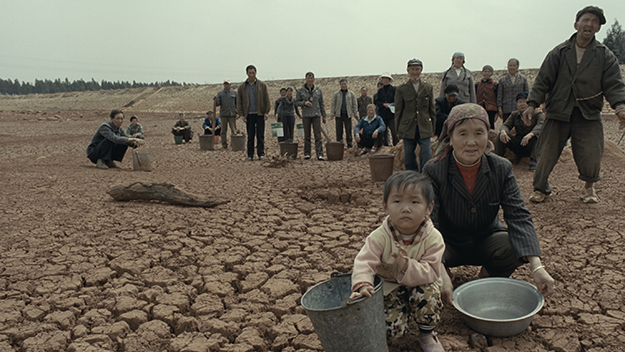Film of the Week: Chinese Portrait

Images from Chinese Portrait (Wang Xiaoshuai, 2018)
A brief sequence in Wang Xiaoshuai’s new documentary depicts the scene at a Chinese coastal resort. In one shot, a man stands gazing out at the sea while children splash around happily and families lounge on the sand in the background; in another, a middle-aged man wearing swimming trunks and a medallion looks to camera quizzically, with the thoroughly rakish look of an ageing holiday Lothario. These may not be not exceptional images in themselves, but they made me realize that this was something I had never seen in a Chinese film before, documentary or fiction: something as ordinary as people enjoying leisure time themselves on the beach.
It’s not that Chinese cinema has necessarily been avoiding this aspect of life as too mundane or undramatic, just surely that contemporary life in China is so vast and multifarious that the national cinema may not be able to trawl in all its facets. Nevertheless, this 2018 documentary by “Sixth Generation” director Wang makes a good attempt at doing that. The first great film of this year, arguably, was Wang Xiaoshuai’s three-hour So Long, My Son, which followed a family through three decades of modern Chinese history; although it is only 80 minutes long, his Chinese Portrait is equally expansive, although in a telegraphic, fragmented manner.
In its English title, the film presents itself as an overall portrait of a nation, but each single image is itself a portrait—of people, locations, lifestyles, traditions. We see Chinese work, leisure, religion (Buddhist and Muslim); we see industry, transport, agriculture, landscape tamed and in revolt. There are just over 60 main shots in Wang’s film—give or take a handful that figure as all but subliminal—nearly all of them locked off, many of them highly composed, even artificial. Shot over 10 years on both film and digital, sometimes emphasizing the portrait aspect by the use of Academy ratio frames with rounded corners—sometimes separated by lengths of leader in various colors—the film offers a range of snapshots of contemporary China.

It’s hard to resist the allusion to still photography. Wang often poses his subjects in stationary groups, while a single element in the picture—a chain, a flapping bit of fabric, or an unruly child—moves to remind us that we’re not looking at stills. These images resemble a set of pictures in a modern photography gallery: most of them have a stillness and composure that makes you want to hold at length on each one before walking on to the next. In some of the larger landscape shots with human figures, you might think of the huge staged compositions of Jeff Wall: a grey vista of tower blocks, with the tiny figure of a street cleaner in day-glo orange wandering in the foreground. The more spectacular images of workplaces—offices, factories, a classroom—have a touch of Andreas Gursky.
The images are presented without commentary, explanatory captions, or even subtitles in those sequences that contain dialogue; there’s barely any music. This is a country laid out before us, but not with appeal to the touristic eye; the non-Chinese viewer is often left to guess at the exact nature of context and content alike, although nearly all the images are fairly transparent and immediate in their effect. Does it help to know, however, that one shot of the director himself shows him at Tiananmen Square? Another image shows a red-robed Buddhist monk with his back to the camera, facing a range of mountains; flags blow in the breeze, wind is heard in the background. Is this in some way a comment on China’s relationship to Tibet? One suspects it might be, but the film tells us nothing.
This is very much, although not entirely, a film about people. Photographed variously by Wu Di, Zeng Jian, Zeng Hu, and Piao Xinghai, many of the shots are posed group portraits, often absolutely still, although not everyone will freeze for the camera. In a photo of a shepherding couple and their flock, the humans stand still while a lamb wriggles in the women’s arms; at a family backyard meal, a little girl wanders around while, conversely, the elderly woman farthest from us gazes intently at the camera. Wang often has a single person looking straight at us out of an otherwise natural shot in which people aren’t apparently aware of the camera at all. In an open-plan office, business appears to go on, as on a normal working day, but one man near the foreground stares at us; similarly, in a university classroom scene full of students writing away, a young woman meets our gaze, immobile, pen to her lips—the seeming naturalness of the scene undermined by the fact that no-one turns a hair when the recess bell rings.

Sometimes Wang Xiaoshuai highlights the self-reflexive aspect to his portraiture, or just its painterliness. Some images show the director himself, a stocky, middle-aged man gazing with a somewhat comic glumness at the camera: in Tiananmen Square, or on the back platform of a moving train (he then cuts away to passengers looking back at the camera, or back at him, although most appear to lose interest after a few moments). In another, the film’s one overt joke, he stands in the yard of a seemingly disused factory, before a line of workers file right past him, ignoring him totally (his nod to the Lumières and the birth of cinema?). We see a group of young women posing in a desolate landscape, while in the foreground, a mainly blank canvas shows the sketched outline of one of them. After a while, the painter appears in shot—Liu Xiadong, whose work was apparently one of the inspirations for this film (a Google search reveals that this image shows him working on a 2010 group portrait called Out of Beichuan). Another image shows a young female dancer standing against a pillar, others lined up in a dark background in sequins and tulle; with its artfully achieved lighting, it seems to channel a painting by Degas or Lautrec.
Edited by Valérie Loiseleux—a long-term collaborator of Manoel de Oliveira and Eugène Green—this leisurely film sometimes frames images in isolation, sometimes juxtaposes them for analogy or contrast, very occasionally uses sound to stitch together suites of seemingly unconnected images. One sequence shows a plane etching a white line across a blue sky, then a factory belching smoke, ice drifting on a river, sheep in a green field gradually sweeping across the entire screen; what connects them is a little symphony of unexplained, seemingly unconnected sounds (beginning with footsteps, odd scratchings) threaded throughout. In images like this, or in a single extended shot of long grass waving in the wind, Chinese Portrait echoes Abbas Kiarostami’s Five; elsewhere its group portraits echo Agnès Varda and JR’s Faces Places.
There is very little event in Chinese Portrait, although one incident is quite genuinely explosive: an excavator with a drill attachment chips away insistently at the corner pillar of a huge concrete industrial building, until it suddenly crashed down with an almighty boom, dust filling the screen. This is one of many images of destruction and reconstruction in the film, some by all accounts relating to the devastating earthquake of the Sichuan province in 2008—such as the apartment block caved in down the middle, like a collapsed cake. By contrast, there are various buildings under construction, some of them glumly functional, as opposed to the glossy display maquette of a city project space with glowing skyscrapers. In its fragmented, montaged way, Chinese Portrait tells as forceful a picture of social change as Wang’s So Long, My Son, which spans several decades and ends with its lead characters returning to the city they once knew, some of the buildings they knew still intact in a city transformed almost beyond recognition.

One of the film’s juxtapositions might sound too overt and pointless when described, yet it makes for an eloquent ending. In the penultimate shot, shot from a low angle, a group of rural workers recede into the distance (the film makes consistently strong use of forced perspective) on a plain of parched, cracked earth. At the forefront is a small child clasping a metal bucket, and a women holding out an empty metal bowl. They seem to be pleading to the camera for food in times of need, and the image would almost be crushingly overstated if not for one element; among this static poised group, the child is fidgeting and looking nervously around, bringing an almost comic touch of disruptive chance to this otherwise contrived-seeming tableau.
In contrast, the following (and final) shot is one of plenty: it’s an open-air restaurant in a city, a vision of movement and life, with a musician seen singing and playing guitar, and some sort of agitated debate going on in the background. Everything is vivid and spontaneous. Scan the image long enough, though, and you’ll notice one of Wang’s poised, still gazers almost hidden on the left side of the screen: a young man looking out at us, absolutely still, a figure of photographic fixity in the middle of cinematic movement and, by way of a sign-off, challenging us to piece together the film’s sprawling imagistic jigsaw for ourselves.
Jonathan Romney is a contributing editor to Film Comment and writes the Film of the Week column. He is a member of the London Film Critics Circle.







